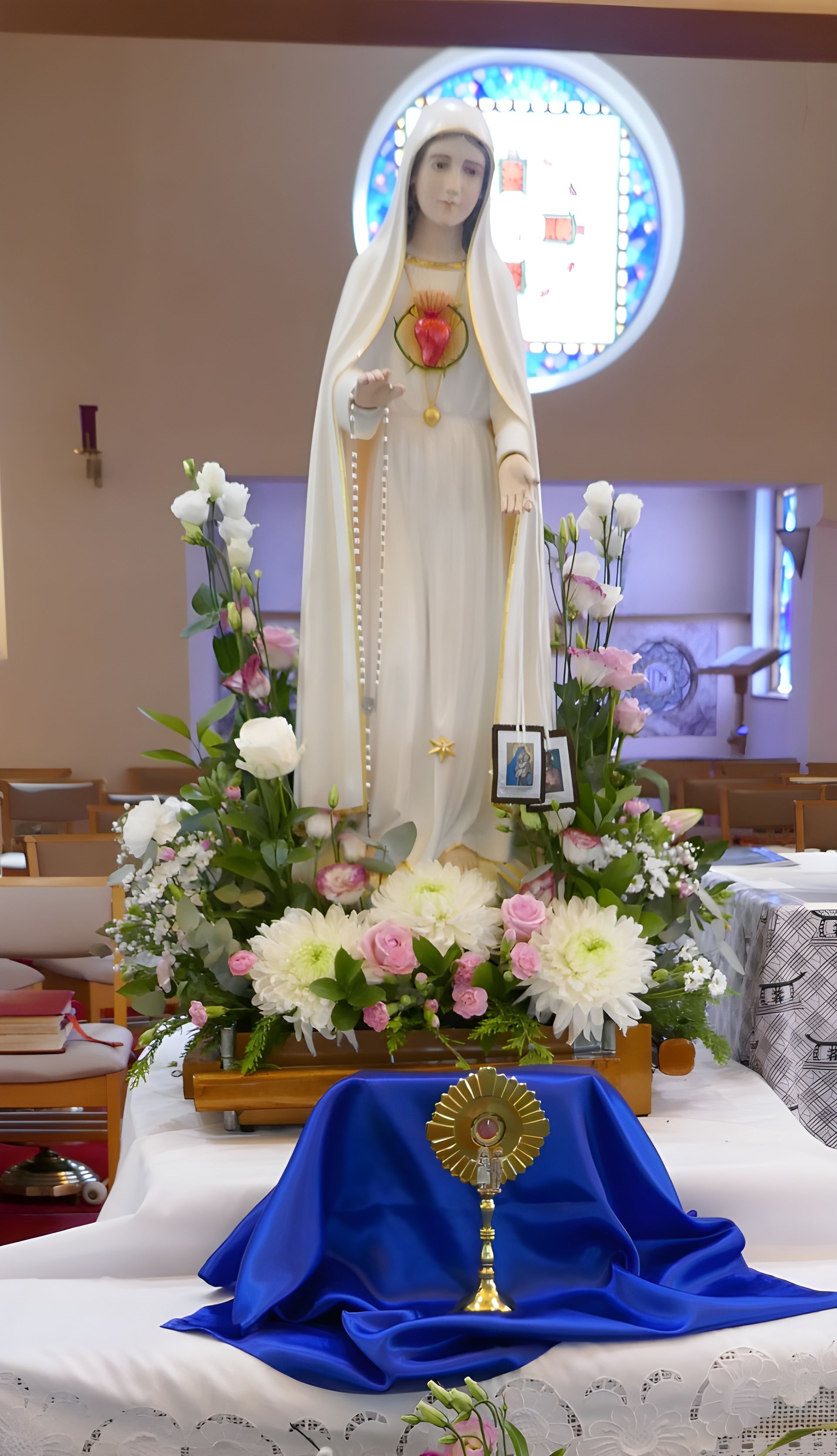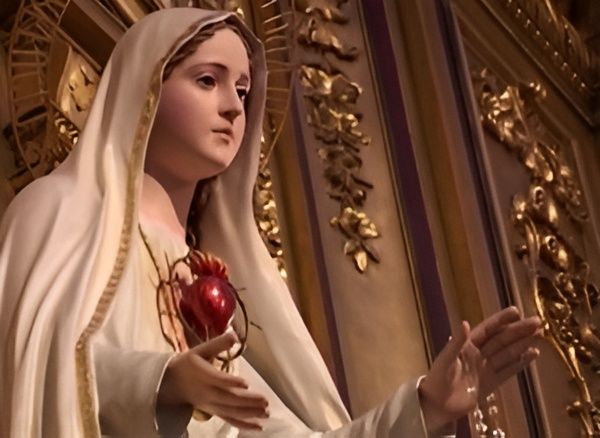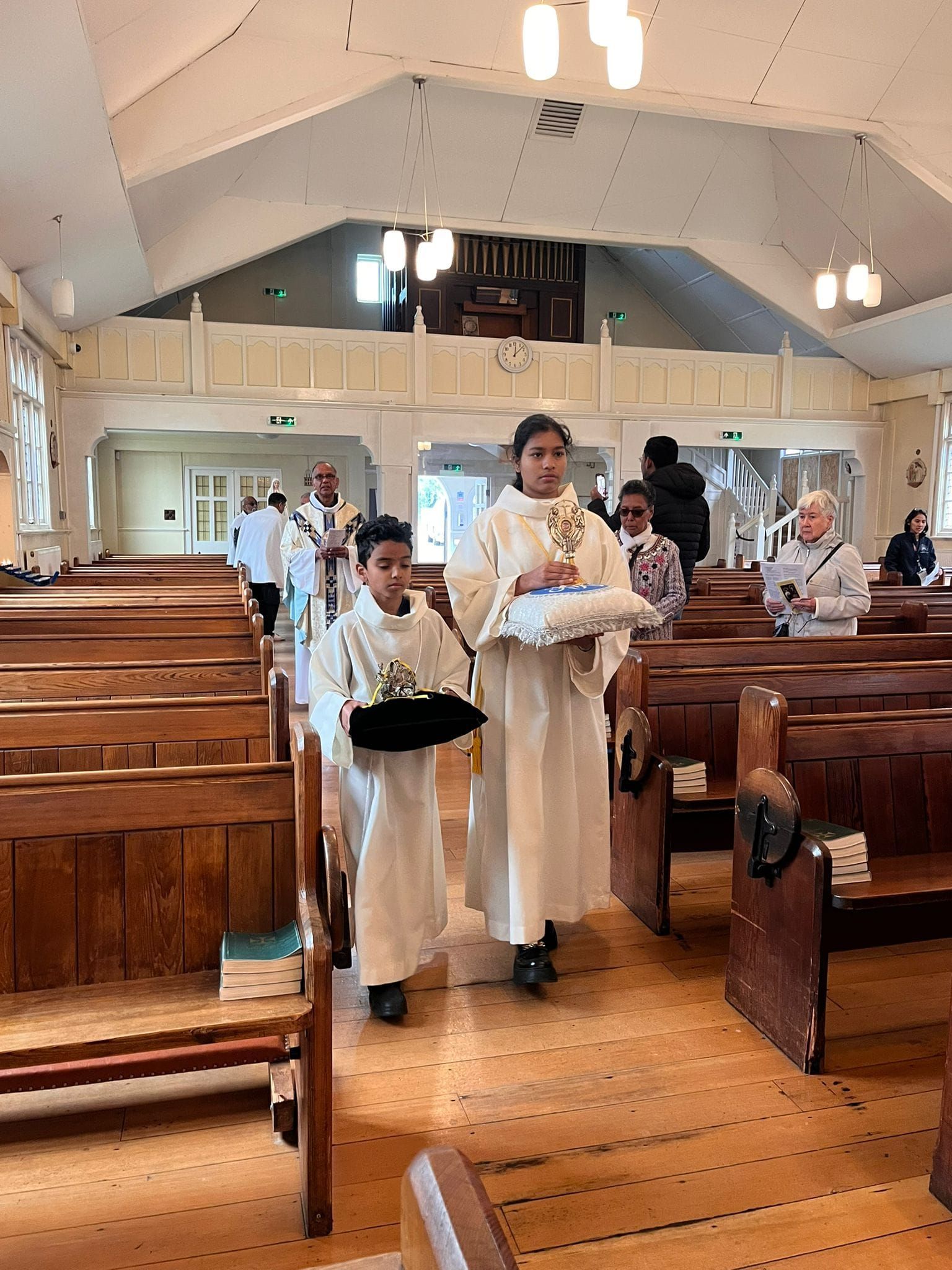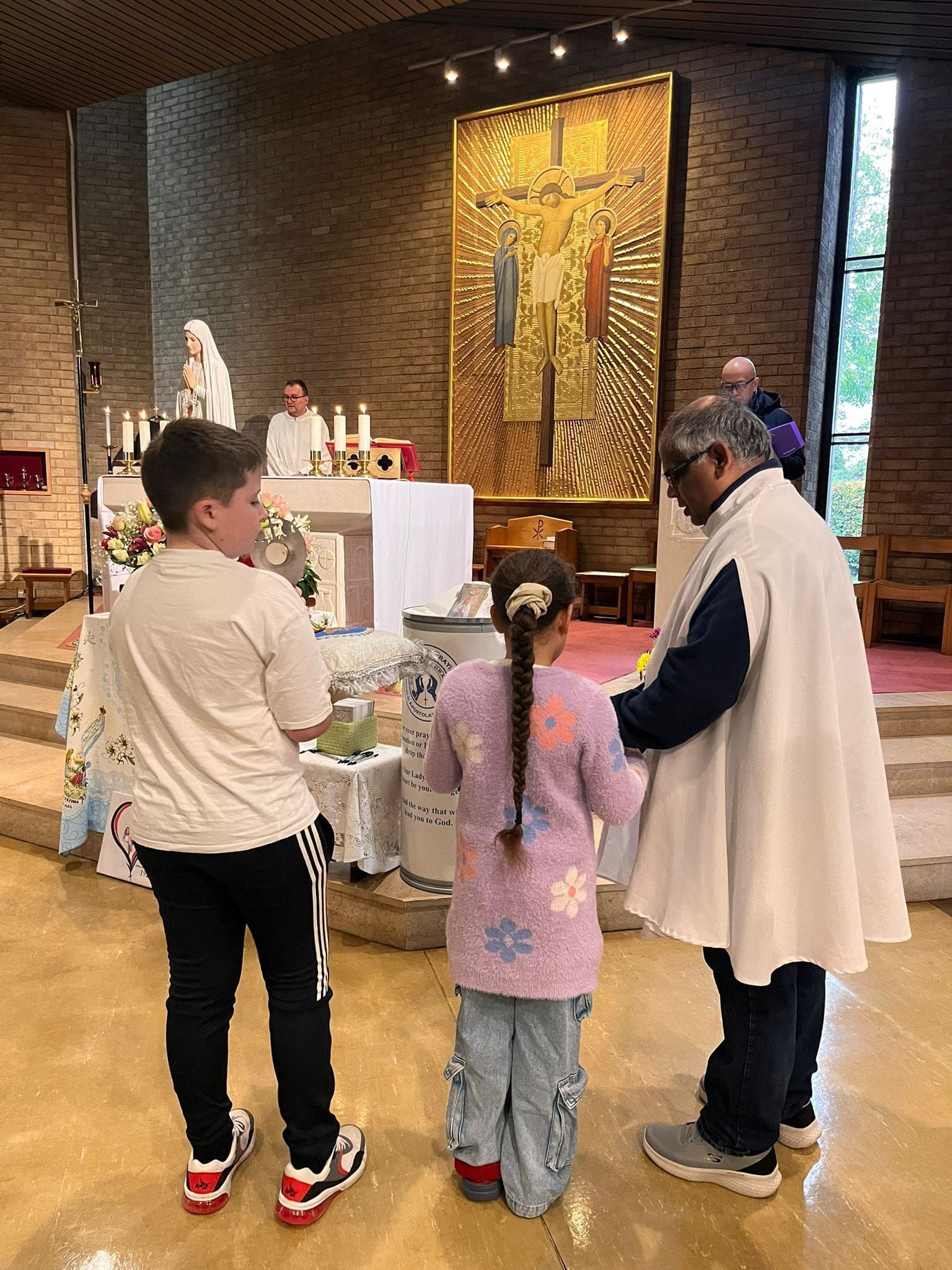Centenary Immaculate Heart Statue
The WAF England and Wales Centenary Pilgrim Virgin Statue of the Immaculate Heart of Mary (CPVSIHM), was blessed at the Chapel of the Apparitions in Fatima, Portugal, in June 2018, by Bishop Guillermo V. Afable, the National Spiritual Director of WAF Philippines, in the presence of many priests and delegates gathered for WAF International Seminar. It’s purpose is to promote Communions of Reparation on First Saturdays and to foster the devotion to Mary’s Immaculate Heart.
The CPVSIHM was also a direct response to the invitation of the “Grace and Mercy International Seminar of the WAF” held at Domus Pacis, the WAF International Headquarters, in Fatima, to rediscover the marvels of Fatima, “the light that came out of Her heart who was Jesus himself,” that transformed the hearts of the little children-shepherds forever.
WAF England and Wales hope that the CPVSIHM will continue to visit many religious houses, convents, parishes and cathedrals to promote the Five First Saturdays devotion, and along with the Relics of Saints Jacinta and Francisco, become an instrument of catechesis on the Sorrowful and Immaculate Heart of Mary, which, surrounded by thorns, urgently needs reparation.

More on the statue
10 December 2025, is the Centenary of the request of the Five First Saturdays of Reparation at Pontevedra, Spain. At Pontevedra, Our Lady promised to assist at the hour of death, with all the graces necessary for salvation, all those who, on the first Saturday of five consecutive months go to confession and receive Holy Communion, recite five decades of the Rosary, and keep her company for a quarter of an hour while meditating on the mysteries of the Rosary, with the intention of making reparation to her.
The devotion to Our Lady’s Immaculate Heart is strongly emphasised in the Fatima message. During the 13 June 1917 apparition, the Blessed Virgin said to Lucia, “Jesus wants to use you to make me known and loved. He wishes to establish the devotion to my Immaculate Heart throughout the world. I promise salvation to whoever embraces it; these souls will be dear to God, like flowers put by Me to adorn his throne.” She also promised Lucia that her Immaculate Heart would be her refuge and the way that would lead her to God.
The First Saturday Devotion of Reparation signifies the intimate union of the hearts of Jesus and Mary. In this devotion, Jesus himself desires reparation for the sins which pierce His Mother’s sorrowful heart, the maternal symbol of her merciful love and her desire for the salvation of all mankind in Him.

A new crown for the CPVSIHM has been made by the firm of Leitao and Irmao, Jewellers, of Lisbon, Portugal, who also made the crown for the Southern Statue.
FATIMA AFTER THE APPARITIONS
Meanwhile, work on the construction of the Capelinha, the Chapel of Apparitions, began on 28 April 1919 and was completed on 15 June; the first Mass was celebrated there on 13 October 1921. The pedestal on which the image of Our Lady stands in the Capelinha marks the exact spot where the little holm oak grew on which Our Lady appeared. In May 1922, Bishop Jose Correia da Silva of Leiria-Fatima, named a commission of enquiry to analyse the facts surrounding the Fatima phenomenon “with strictness and impartiality”.
On 10 December 1925, Sr Lucia, who had become a postulant with the Dorothean Sisters, was at their convent in Pontevedra, Spain, when she saw another apparition, this time of Mary with the Child Jesus. Mary told Lucia that she promised all the graces necessary for salvation to those who, on the first Saturday of five consecutive months, confessed, received Holy Communion, recited five decades of the rosary, and meditated on the rosary for fifteen minutes, all with the intention of making reparation to her Immaculate Heart.
Meanwhile, on 13 January 1924, Mass was celebrated for the first time inside the Capelinha, while on 26 June 1927, the bishop presided for the first time at an official event—the inauguration of the 14 kilometre Way of the Cross to the Cova da Iria, where he celebrated Mass in the presence of 400 pilgrims. Building work on he Basilica of Our Lady of the Rosary of Fatima was begun in 1928, and it was consecrated on 7 October 1953. It has 15 altars dedicated to the 15 mysteries of the Rosary. The bodies of Jacinta and Francisco were moved to their present positions, to the left and right of the main altar, in the early 1950s, and Sr Lucia’s body was interred in the Basilica in 2008 next to Jacinta’s. The mortal remains of Bishop Correia da Silva, who died in 1957, are interred in the Chancel.
Prior to this, on 13 June 1929 Sr. Lucia, while at prayer in the convent chapel at Tuy, saw a vision of the Most Holy Trinity, with Mary standing on the altar displaying her Immaculate Heart in her left hand. It was on this occasion that Mary asked the Pope, in union with all the bishops of the world, to make the [collegial] consecration of Russia to her Immaculate Heart that she had announced during the July 1917 apparition.
On 13 October 1930 the Bishop issued a pastoral letter on the apparitions, which, after recounting the events at Fatima, contained the following brief but important statement:
“In virtue of considerations made known, and others which for reasons of brevity we omit; humbly invoking the Divine Spirit and placing ourselves under the protection of the most Holy Virgin, and after hearing the opinions of our Rev. Advisors in this diocese, we hereby:
- Declare worthy of belief, the visions of the shepherd children in the Cova da Iria, parish ofFatima, in this diocese, from the 13th May to13th October, 1917.
- Permit officially the cult of Our Lady of Fatima.”
In thanksgiving for this development, six months later, on 13 May 1931, a vast pilgrimage of around 300,000 people came to Fatima to participate in a ceremony presided over by Cardinal Cerejeira, Patriarch of Lisbon, at which all the bishops of Portugal made the first consecration of their country. It was this consecration, and that of 1938, which preserved Portugal from the violent attack on the Church in the Spanish Civil War, and its renewal in 1940 saved Portugal from being dragged into the horrors of the Second World War.
Fatima developments from World War II onwards
On 31 October 1942, during World War II, Pope Pius XII, speaking in Portuguese by radio, consecrated the world to the Immaculate Heart of Mary, with a special mention of Russia, in response to the request he had received in a letter from Sr Lucia. Some months later Sr Lucia said that as a result of this act, God promised to end the war soon.
On 13 May 1946, Cardinal Masella, the Papal Legate, crowned the Statue of Our Lady of Fatima in the Capelinha as Queen of Peace. This crown was made from gold melted down from wedding rings donated by the women of Portugal, and it also contains over 4,000 precious stones, which they contributed in thanksgiving for Portugal having been spared the horrors of the Spanish Civil War and the Second World War.
On 13 October 1951, Cardinal Tedeschini, who was in Fatima for the closing of the Holy Year, revealed that in October 1950, at the time when he had promulgated the dogma of Mary’s Assumption into heaven, Pope Pius XII had witnessed a repetition of the solar miracle of 13 October 1917, while he was walking in the Vatican gardens.
Cardinal Roncalli, the Patriarch of Venice, and the future Pope John XXIII, presided at the ceremonies at Fatima on 13 May 1956, while, on 21 November 1964, Pope Paul VI, at the conclusion of the third session of the Second Vatican Council, proclaimed “the Most Blessed Mary Mother of the Church”; the Pope also considered it was “particularly opportune” to recall Pius XII’s consecration of the world to the Immaculate Heart of Mary; and bearing that consecration in mind, he announced before the 2,500 Council Fathers, that a Golden Rose was to be presented to the Sanctuary of Fatima (this act was carried out on 13 May 1965 by Cardinal Cento, the Papal Legate); and the Pope concluded his address by proclaiming, “to your Immaculate Heart, O Mary, we commend the entire human race”.
Pope Paul VI came to Fatima on 13 May 1967 to celebrate the 50th anniversary of Our Lady’s first Apparition, and to pray for world peace and Church unity. In a significant sign of papal approval for the message of Fatima, the Pope invited Sr Lucia to join him on the external altar in front of the crowds, and in his Apostolic Exhortation Signum Magnum, issued on the same day, Paul VI urged “all members of the Church to consecrate themselves once again to the Immaculate Heart of Mary and to translate this pious act into their daily lives”.
Ten years later, on 10 August 1977, the future Pope John Paul I, Cardinal Luciani, Patriarch of Venice, came on pilgrimage to Fatima.





